Join More Than 50,000+ Subscribers and get latest camera news and rumors
NEW CAMERA VIDEOS ON YOUTUBE
|
By admin, on May 31st, 2014
Fujifilm X100s vs Nikon Coolpix A vs Ricoh GR – Best APS-C Compact camera of 2014
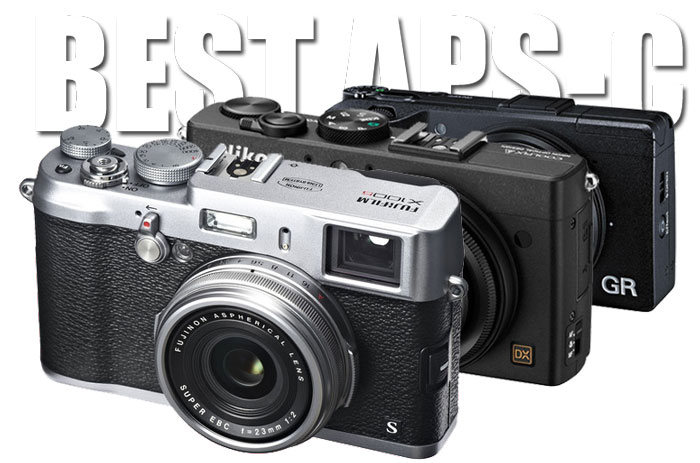
Planning to buy your first APS-C sensor compact camera?, we have compared best three compact camera specification and high ISO images below…
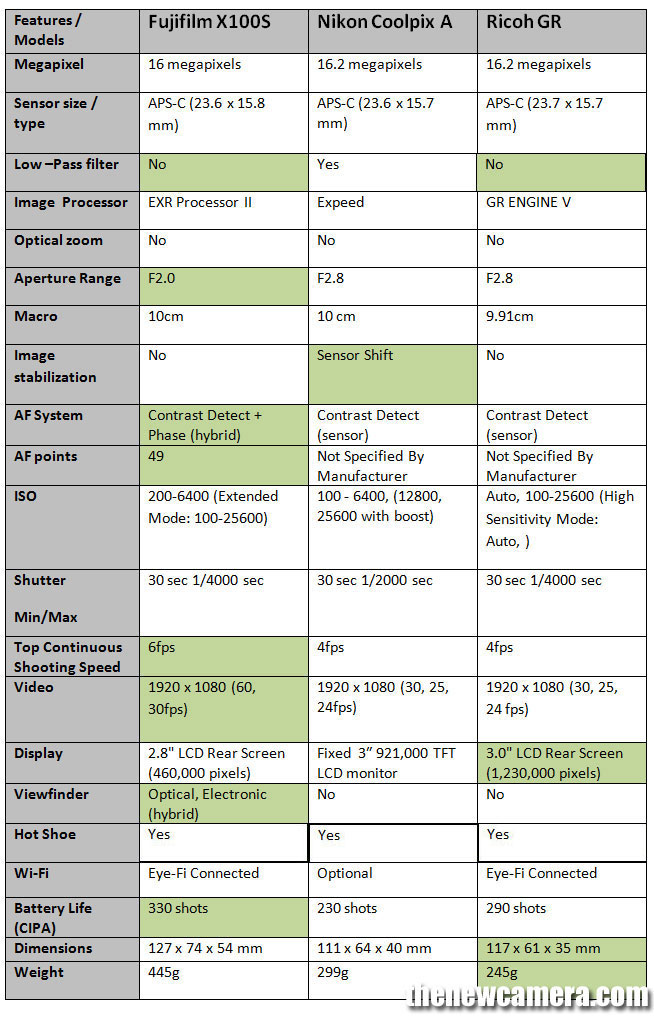
Sensor: Fujifilm features advance 16 Mp APS-C X-Trans CMOS II Sensor, X-Trans sensor uses a unique randomized pixel array in order to avoid the use of a resolution-reducing optical low-pass filter, +1 you also get bright F2.0 lens (1-stop bright lens compared to both competitors ).
Both Nikon coolpix A and Rioch GR have same type of sensor 16.2 MP CMOS sensor, even the lens used in both the camera features same F2.8 Aperture, but the Rioch GR doesn’t have low-pass filter so we will sure see sharp images from Ricoh GR camera compared to coolpix A.
From the specification comparison we can clearly see that Fuji will produce better images compared to both the camera due to 1-stop bright lens and absence of low-pass filter.
AF-system: The Fuji X100s have active phase AF point within the sensor, the Intelligent Hybrid AF system of Fuji X100s uses both contrast- and phase-detection methods to acquire focus quickly and accurately, on the other hand both Nikon coolpix A and Rioch GR uses traditional contrast based AF system..will do slower AF than Fuji X100s.
The continuous shooting speed of Fujifilm X100s is faster (6fps) compared to Nikon coolpix A(4fps) and Ricoh GR(4fps).
Image stabilization: The Image stabilization only available in Nikon coolpix A, Fuji X100s and Ricoh GR doesn’t have built-in or lens based Image Stabilization.
Video: The Fuji X100s can shoot Full HD videos @ 60fps, Nikon coolpix A and Ricoh GR limited to 30 fps only.
Viewfinder: The X100s comes with optical and electronic viewing tools are incorporated into the unique Hybrid Viewfinder, eye-sensor is located on the viewfinder to automatically turn off the rear 2.8″ LCD monitor during eye-level viewing. Ricoh GR and Nikon coolpix A doesn’t have viewfinder.
Finally Image Comparison
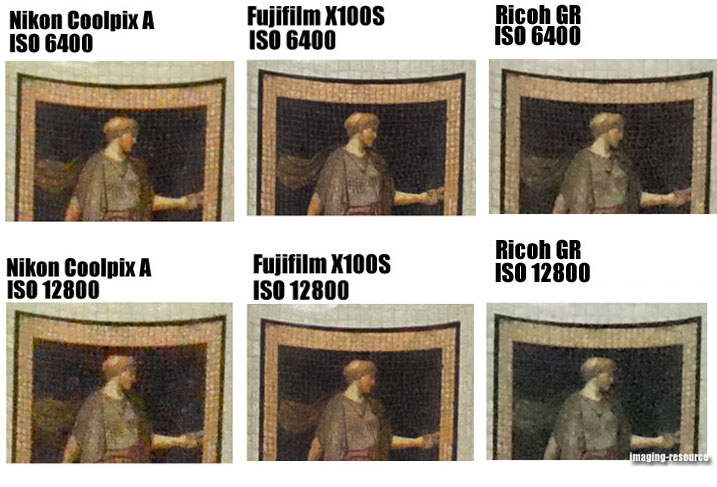
From the image comparison above we can clearly see the Fuji X100s is showing excellent results at High ISO. The Ranking based on image quality is …
#1 Fujifilm X100s
#2 Ricoh GR
#3 Nikon Coolpix A
Verdict: The clear winner of specification and image comparison is FUjifilm X100s, after that we have affordable Rioch GR and finally at the bottom we have Nikon coolpix A.
Buy Fujifilm X100s B&H and AMAZON | Nikon Coolpix A from Amazon | B&H | Ricoh GR features B&H
By admin, on June 16th, 2013

Take a look between the comparison of Leica X vario and Fujifilm X100S, the Leica X vario features 16 MP, APS-C CMOS image sensor and ISO 100-12500 on the other hand Fujifilm X100S features 16MP APS-C X-Trans CMOS II Sensor and Expandable ISO 100-25600, take a look at the Major Specification Below.
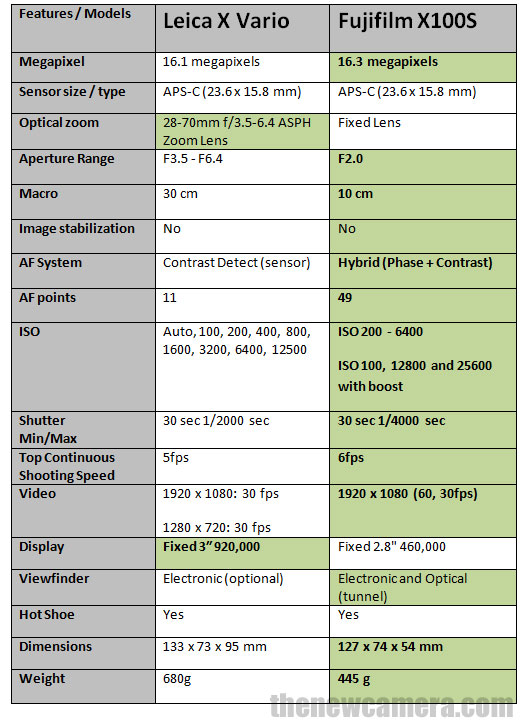
About the sensors
A large APS-C CMOS image sensor is integrated into the X100S to provide high image quality and detail. Using Fujifilm’s unique X-Trans bespoke pixel array, the sensor is designed with a randomized pixel pattern to eliminate the need of an optical low-pass filter for reducing moiré and aliasing. By removing this filter from the design, higher image sharpness is possible. Lens Modulation Optimizer (LMO) factors are also taken into account using the EXR Processor II, which helps to automatically compensate for aberrations and diffraction blur in order to produce images with the utmost inherent sharpness. The image sensor also utilizes backside illumination technology to help with the integration of phase-detection pixels into the sensor for improved autofocus performance without affecting image quality.
Not much details available about Leica X vario uses APS-C size sensor features a resolution of 16.1MP.
Lens
Fujifilm features built-in 23mm f/2 fixed focal length lens gives a 35mm-equivalent focal length of 35mm, making it more compact and easy to carry.
Leica X vario features Vario-Elmar 28-70mm f/3.5-6.4 ASPH Zoom Lens (35mm Equiv) , it give you more range but the camera size also increases.
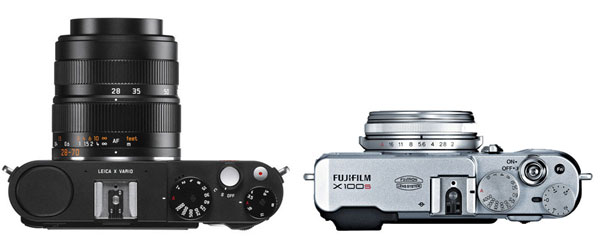
AF System
Intelligent Hybrid AF is a quick, responsive autofocus system that employs both contrast- and phase-detection methods, focus can be attained in as little as 0.08 second.
Fujifilm offers 42 point AF system on the other hand Leica is limited to 11 point only.
ISO Range
The combination of the sensor and processor enables a native sensitivity range from ISO 200-6400, which is further expandable to ISO 100-25600. Leica Vario X offers an ISO sensitivity range of 100-12500.
Video mode
Capture HD 1920×1080 video at 30fps, In Fujifilm X100S Full HD movie recording is supported up to 1920 x 1080 at 60fps with a 36Mbps bit-rate for clear, fluid-looking videos.

Display
Both camera 3.0-inch, wide-angle LCD monitor, which has a resolution of 920k pixels. Fujifilm X100S features hybrid viewfinder.
Verdict: Based on price and major specification difference, we highly recommend you to buy Fujifilm X100S
Price:
| Fujifilm X100S |
Leica X Vario |
| |
|
By admin, on May 15th, 2013
High ISO Test – Ricoh GR vs Nikon Coolpix A vs Fujifilm X100S vs Canon G1 X, Ricoh GR features 16 megapixel APS-C CMOS image sensor that offers low-noise characteristics, 18.3mm F2.8 GR lens equivalent to 28mm in the 35mm format, take a look at the Image comparison below.
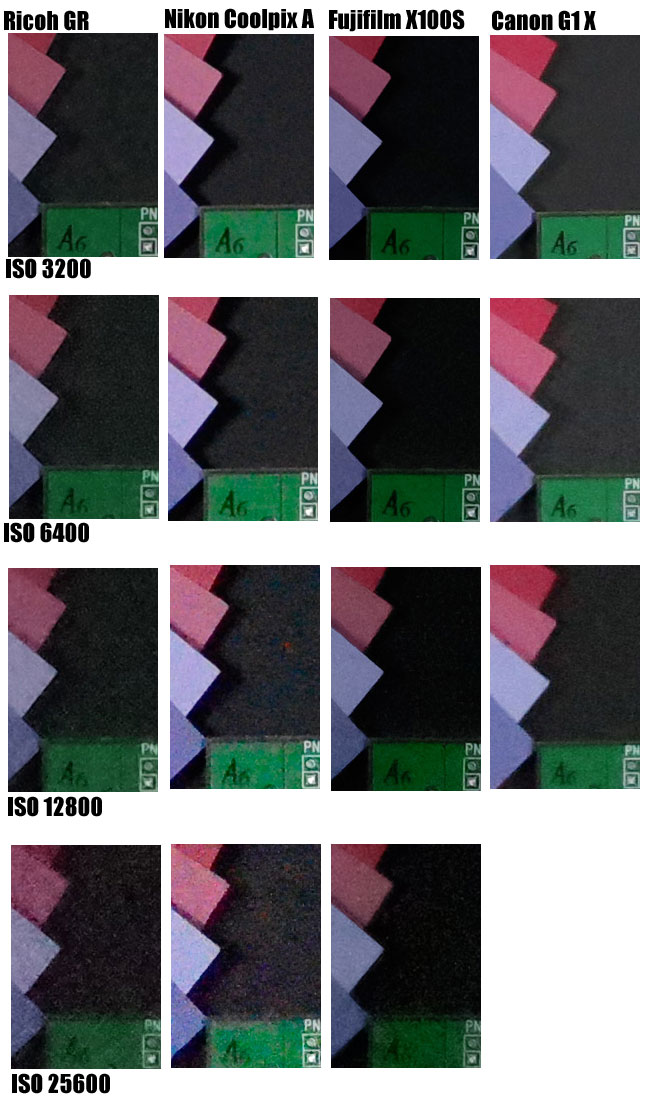
the scene is illuminated at 200 lux, the GR positioned in M mode with a couple 1/4 s and f / 5.6 ISO value of 100. The images are visible at 100% and you can download the raw files from focus-numerique
Image quality of of Canon G1X look stunning at ISO 3200 and 6400, Nikon Coolpix A performed better than Ricoh GR and Fujifilm X100S is the best camera for low light photography.
Also see – Ricoh GR comparison review
Buy Latest Products from Amazon
- Fujifilm X100S will cost you approx $1,299.00, available at B&H and AMAZON
- The ultra compact APS-C RICOH GR will cost you approx $796, available at B&H
- Buy Nikon Coolpix A from Amazon | B&H
- Buy Canon G1 X from Amazon
By admin, on April 21st, 2013

Ricoh GR vs Fujifilm X100S Specification Comparison, both camera features APS-C sensor and same ISO range, take a look at the other major difference.

Sensor and Image Processor:
Fuji X100S: Features newly-developed 16.3 million pixels APS-C X-Trans CMOS II sensor, no low-pass filter and EXR Processor II,
Ricoh GR: Featuring a 16 megapixel, APS-C-sized CMOS sensor, no low-pass filter and newly developed GR ENGINE V Image Processor.
Auto Focus
Fujifilm X100S features Hybrid AF system (Phase+Contrast), Ricoh GR limited contrast detect AF only.
Fuji X100S: The newly-developed X-Trans CMOS II sensor features Phase Detection pixels, when combined with EXR Processor II offers world’s fastest AF in as little as 0.08 seconds, start-up time of only approx. 0.5 seconds.
Ricoh GR: Ricoh GR take 0.20 Sec to do AF. No more data available.
Lens:
Fujifilm X100S features more bright lens, Max aperture of Fujifilm X100S touches 2.0, Ricoh GR limited to F2.8.
Shutter
Ricoh GR features better shutter range compared to fujifilm X100S.
Video:
Fujfilm offers 60fps in Full HD video mode, Ricoh GR limited to 30 fps in Full HD video mode.
Viewfinder
No viewfinder available in Ricoh GR, X100S’s Hybrid Viewfinder combines both an Optical and an Electronic Viewfinder.
Verdict: Based on Specification Comparison Review Fujifilm X100S is a clear winner
Price Factor: Ricoh GR is affordable compared to Fujifilm X100S,
- Fujifilm X100S will cost you approx $1,299.00, available at B&H and AMAZON
- The ultra compact APS-C GR will cost you approx $796, available at B&H
By admin, on March 8th, 2013
 Nikon Coolpix A vs Fujifilm X100S, take a look at the high-end APS-C sensor compact specification comparison and share your thoughts with us. Nikon Coolpix A vs Fujifilm X100S, take a look at the high-end APS-C sensor compact specification comparison and share your thoughts with us.
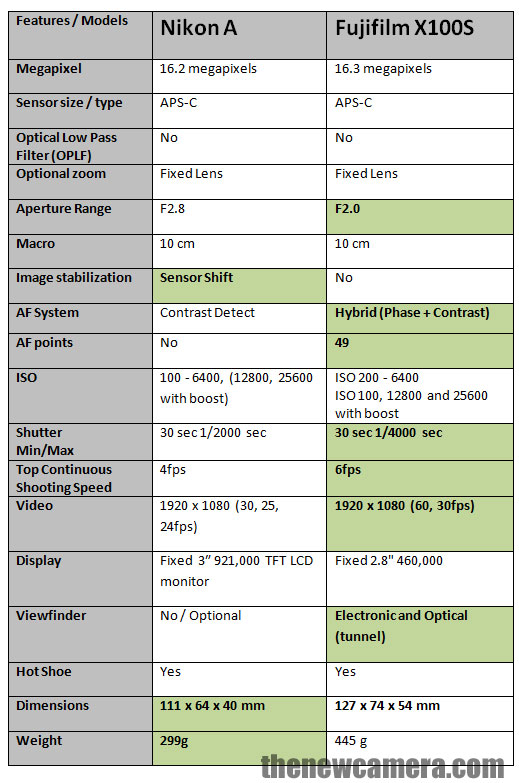
Sensor
Nikon uses Sensor of Nikon 7000 / D5100 DSLR ,
The fujifilm features newly developed X-Trans CMOS sensor, the fujifilm X100s sensor is completly redesigned and features Phase AF points within the sensor
so you get a approx 4 year old sensor technology in Nikon coolpix A, I don’t know why Nikon used old 16Mp sensor since it already have high performance 24Mp APS-C sensor from Sony and Toshiba.
Lens
Fujifilm features better / bright lens compared to Nikon coolpix A.
No-Optical Low Pass Filter (OLPF) – Both Camera features No-Optical low pass filter.
Auto Focus –
Nikon features Contrast detect AF system, for still and video mode.
The Fujifilm X100s features Phase AF + Contrast AF (Hybrid AF), the Fuji X100s offers 0.08 second of AF Speed.
During Movie mode Fujifilm X100s Phase-detect AF effective for movie shooting.
Top Continuous Shooting Speed – Fujifilm features fast continuous shooting speed.
Video Mode
Fujfilm X100s offers you 1080p 60fps Full HD recording with Phase AF, Nikon coolpix A is limited to 30fps at Full HD mode and have contrast detect AF.
14bit RAW Support – both features 14bit RAW Support
Price Difference – Fujifilm X100S will cost you approx $250+ compared to Nikon coolpix A
Conclusion
Based on specification comparison review we recommend Fujifilm X100S.
Buy Fujifilm X100S from Amazon
Buy Nikon Coolpix A from Amazon
By admin, on January 25th, 2013
 Fujifilm X100s features better sensor, Advance image processor and better video mode, See the detailed specification specification comparison review of Fujifilm X100s vs Fujifilm X100. Fujifilm X100s features better sensor, Advance image processor and better video mode, See the detailed specification specification comparison review of Fujifilm X100s vs Fujifilm X100.
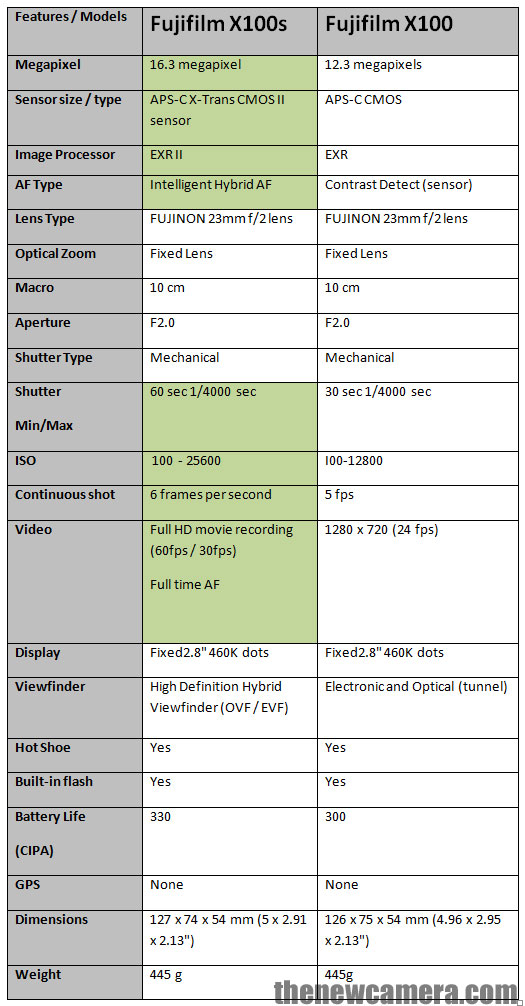
Sensor
The fujifilm features newly developed X-Trans CMOS sensor, the fujifilm X100s sensor is completly redesigned and features Phase AF points within the sensor
No-Optical Low Pass Filter (OLPF) – X-Trans CMOS II incorporates an original color filter array with a highly random pattern, eliminating the need for an optical low-pass filter (OLPF). These filters are used in conventional systems to inhibit moiré at the expense of resolution. The X-Trans CMOS II array lets the sensor capture unfiltered light from the lens, achieving an unprecedented level of resolution.
ISO – The Fujifilm X100s have extended senstivity range of 100 – 25600, X100 is limited to 100
Less Noise – According to fujfilm the test says the fujfilm X100s have more details and approx 30% less noise than Fuji X100.
Due to the new OLPF-less architecture the Image captured by fujifilm X100s have more details compared to fujifilm X100 (when we see it at 100% scale), Take a look at Resolution Comparison and High-Sensitivity Comparison.
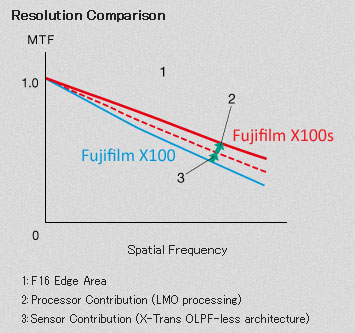
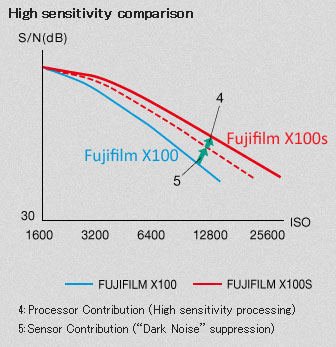
EXR Processor II
The newly developed processor speed-up the X100s to a next level, take a look at stats
- Fast AF performance: Fujifilm X100s features Blazing fast AF speed of 0.08 sec , compared to 0.22 sec for X100
- Quick startup – X100s take only 0.9 sec vs X100 2 sec.
- You get Faster continuous shooting (6 fps vs 5 fps) + Large buffer, Fujifilm X100s offers you 31 frames vs 10 frames of X100 in JPEG Large/Fine mode.
- Less shot-to-shot time in single shot drive mode (0.5 sec vs 0.9 sec)

Auto Focus
The Fujifilm X100s have Phase AF + Contrast AF (in short Hybrid AF), the Fuji X100s offers 0.08 compared to Fuji X100 which offers 0.22 second of AF Speed.
During Movie mode Fujifilm X100s Phase-detect AF effective for movie shooting, AF-S focus mode available (only AF-C and MF on X100).
Video Mode
Fujfilm X100s offers you 1080p 60fps Full HD recording, with 36Mbps bitrate, X100 is limited to 720p 24fps.

other new features
- Auto mode ISO increased to 6400
- 14bit RAW Support
- Minimum shooting distance using OVF reduced to 50cm (X100 have 80cm)
- Minimum focus – normal shooting distance is now 21cm (X100 have 40cm)
- Eye-Fi card support
- bit more battery life
Conclusion
- Fujifilm features better sensor
- No-Optical Low Pass Filter (OLPF)
- Hybrid AF (Phase + Contrast)
- Phase AF during Video Recording
- 30% less noise in images compared to X100
- EXR II processor–> Fast Start-up, AF and Less shot-to-shot time
- Auto mode ISO increased to 6400
- Expandable ISO increased to 25600
- 14 bit RAW support
- Eye-Fi Card Support
We highly recommend you to buy Fuji X100s , no reason to buy X100.
Buy Fujifilm X100S from Amazon || Buy Fujifilm X100S from B&H
By admin, on January 9th, 2013
Does the new Fujifilm X100s have better image quality than Fujifilm X100? let’s find out the answer
We know that the new fujfilm X100s have…
- New Sensor – APS-C 16M X-Trans CMOS II sensor
- No OPLF – OLPF-less architecture
- Advance Image processor – powerful EXR Processor II
According to fujfilm the test says the fujfilm X100s have more details and approx 30% less noise than Fuji X100.

Due to the new OLPF-less architecture the Image captured by fujifilm X100s have more details compared to fujifilm X100 (when we see it at 100% scale), Take a look at Resolution Comparison and High-Sensitivity Comparison.


|
KEEP THIS BLOG ALIVE - Support New Camera Buy Canon Lenses, Buy Music CD or Digital Camera at amazon it helps this site, and you do not pay anything extra, it is just a way to help support this site.

|
























